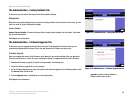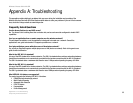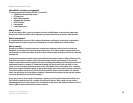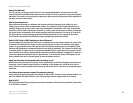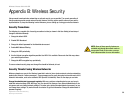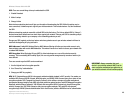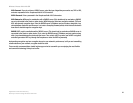
40
Appendix B: Wireless Security
Security Threats Facing Wireless Networks
Wireless-G Access Point with SRX
SSID. There are several things to keep in mind about the SSID:
1. Disable Broadcast
2. Make it unique
3. Change it often
Most wireless networking devices will give you the option of broadcasting the SSID. While this option may be
more convenient, it allows anyone to log into your wireless network. This includes hackers. So, don’t broadcast
the SSID.
Wireless networking products come with a default SSID set by the factory. (The Linksys default SSID is “linksys”.)
Hackers know these defaults and can check these against your network. Change your SSID to something unique
and not something related to your company or the networking products you use.
Change your SSID regularly so that any hackers who have gained access to your wireless network will have to
start from the beginning in trying to break in.
MAC Addresses. Enable MAC Address filtering. MAC Address filtering will allow you to provide access to only
those wireless nodes with certain MAC Addresses. This makes it harder for a hacker to access your network with
a random MAC Address.
WEP Encryption. Wired Equivalent Privacy (WEP) is often looked upon as a cure-all for wireless security
concerns. This is overstating WEP’s ability. Again, this can only provide enough security to make a hacker’s job
more difficult.
There are several ways that WEP can be maximized:
1. Use the highest level of encryption possible
2. Use “Shared Key” authentication
3. Change your WEP key regularly
WPA. Wi-Fi Protected Access (WPA) is the newest and best available standard in Wi-Fi security. Four modes are
available: WPA-Personal, WPA2-Personal, WPA-Enterprise, and RADIUS. WPA-Personal gives you a choice of two
encryption methods: TKIP (Temporal Key Integrity Protocol), which utilizes a stronger encryption method and
incorporates Message Integrity Code (MIC) to provide protection against hackers, and AES (Advanced Encryption
Standard), which utilizes a symmetric 128-Bit block data encryption. WPA2-Personal only uses AES encryption,
which is stronger than TKIP. WPA-Enterprise offers two encryption methods, TKIP and AES, with dynamic
encryption keys. RADIUS (Remote Authentication Dial-In User Service) utilizes a RADIUS server for authentication.
IMPORTANT: Always remember that each
device in your wireless network MUST use the
same encryption method and encryption key or
your wireless network will not function properly.



